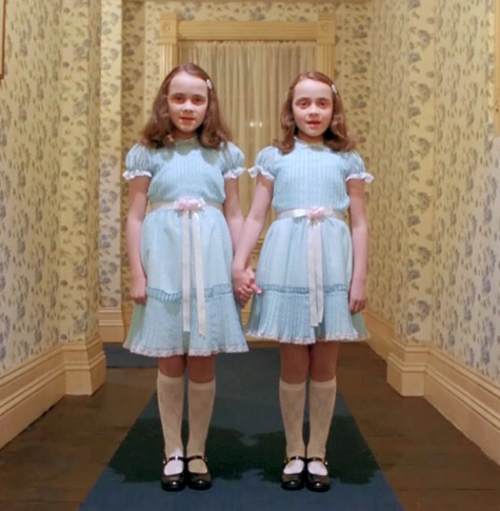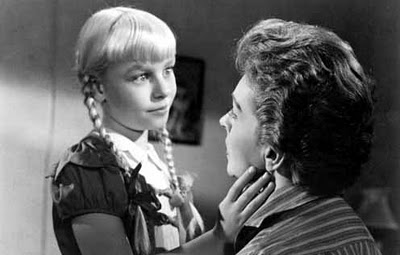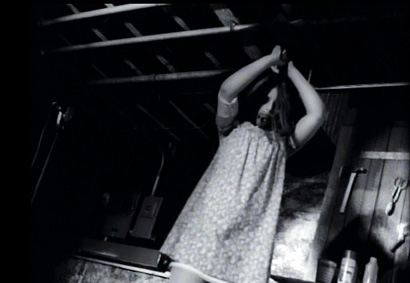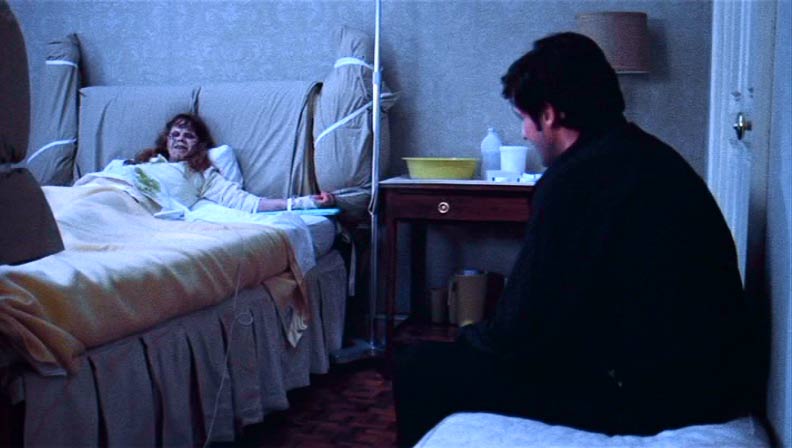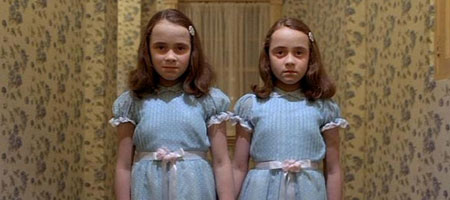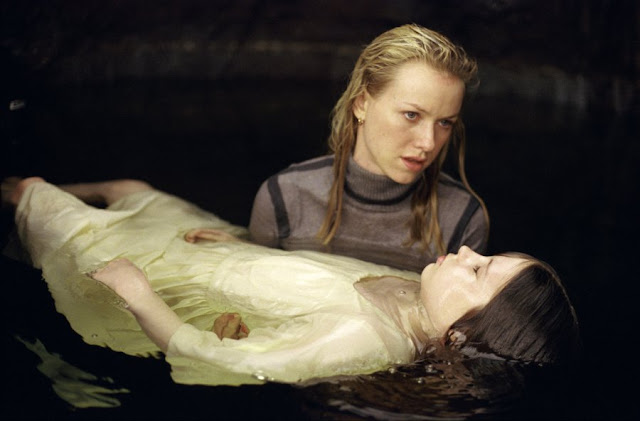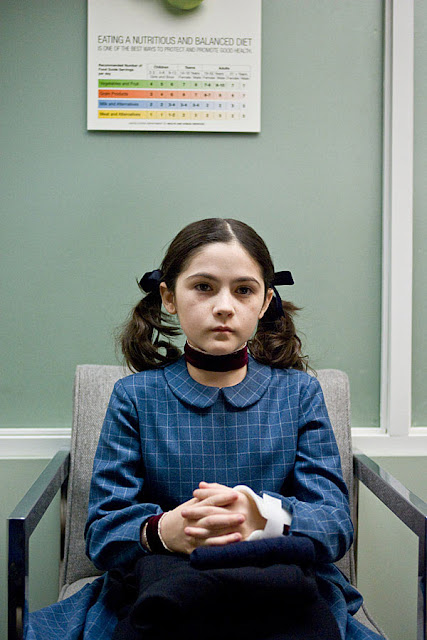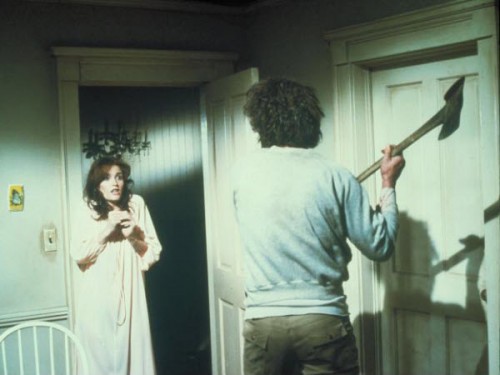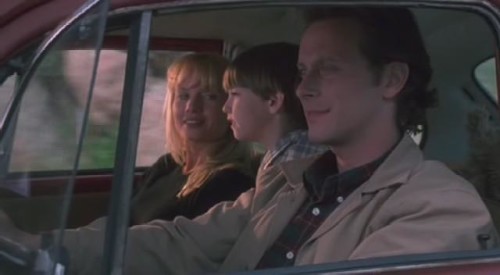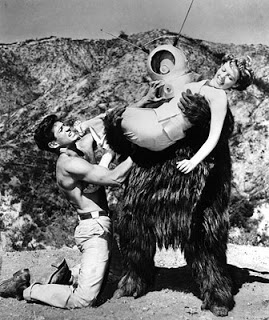This guest post by BJ Colangelo appears as part of our theme week on The Terror of Little Girls.
Horror films frequently utilize little girls as a “go-to” scare tactic. As the sound disappears in a dark and spooky house covered in cobwebs and shadows, a little girl’s laugh or even a song will echo throughout the halls. The contrast of something so seemingly innocent found in a dark and uninviting environment has been used for decades. Whether it’s the iconic and eerie request of the Grady sisters asking Danny Torrance to play forever (and ever, and ever, and ever) in The Shining, or the innocent announcement of “They’re Heeeeere” from little Carol Anne Freeling in Poltergeist, little girls are as much of a scaring staple as a shrieking cat or a set of wailing violins. While there are the exceptions like Damien in The Omen or Barto in The Unborn, for the large part, little girls are used much more frequently in killer kid/child possession/child ghost films. In the same breath, the safety of little girls is valued far more than the safety of little boys. This double standard shown with little girls in horror films perpetuates the idea that women, regardless of age, are constantly in a state of conflict.

Little girls are often what we associate with innocence. Girls are said to be born out of “sugar, spice, and everything nice,” which attaches a stigma to women from birth that is unrealistic. Society is conditioned to believe this ridiculous myth, which changes the way we value little girls over little boys. When little girls in horror films aren’t used as demons/ghosts/killers/etc. and instead exist as just human, the importance of their survival is much greater than any other character. Referring back to Carol Anne Freeling in the Poltergeist franchise, the entire film is centered on protecting and saving her. Carol Anne’s brother, Robbie, arguably endures the more traumatic events in the film, but the focus still remains on Carol Anne. Yes, Robbie’s trees, gravity, his own toys, and his bedroom are torturing and “taken” by the spirits in the house, but the entire focus stays on protecting Carol Anne. Never mind the years of therapy Robbie may require to help him after the tree outside of his room tried to kill him, we still only care about Carol Anne simply because as a little girl, we feel that she constantly needs protecting.
Even when little girls are presented as the villains, we still care more about their survival than little boys. The Swedish vampire hit, Let The Right One In, shows Eli, a vampire girl around the same appearing age as her male counterpart, Oskar. Eli is capable of taking care of herself (and proves it throughout the course of the film) while Oskar is frequently bullied and shown as weak and in need of protection every step of the way. However, Eli’s survival is the one we focus on the most. Whether it’s aggravation towards her helper, Hakan, and his insolence that has now put her safety in jeopardy, or the fact an angry townsperson is hot on her trail to kill her, we sympathize with Oskar’s bullying, but we don’t invest in his safety quite like we do Eli’s. We expect Oskar to “deal” with his issues like he always had done before, but with Eli, we constantly want those around her to “save” her, even though she could do it on her own if she chose.

In Wes Craven’s The People Under the Stairs, we also witness intersectionality at play. Poindexter “Fool” Williams, is a young African-American boy trapped in a house of horrors. While he appears to be about the same age as the Caucasian girl, Alice Robeson, we value her safety far more than we do Fool’s. From the get-go, Fool is presented as almost deserving to be in trouble because he’s a poor Black child, and the angelically white Alice is stuck living in a home with abusive parents. The threat from “Mommy and Daddy” Robeson is much greater toward Fool, but we still shift our focus toward Alice and sense a greater sense of distress towards her survival. Fool is presented as not only a troublemaking youth, but also as the undisputed hero of the film. We believe that this poor Black child is capable enough of making it out alive because “he should be used to survival” while we see Alice as weak and with a lack of “street smarts.” It’s a tragic truth, but this sort of value on the young white female is something that is commonly reflected in the way the media portrays lost children (aka: missing white woman syndrome).

At the same time, despite our value of the lives of little girls over just about anyone else in a horror film, girls are used overwhelmingly more than boys as a source of “evil” in horror films. Cathy’s Curse, The Exorcist, Silent Hill, The Bad Seed, The Ring, The Shining, Orphan, Night of the Living Dead, Alice Sweet Alice, The Last Exorcism, The Amityville Horror, Case 39, and countless other films have all portrayed little girls as the perfect vessel for pure, unadulterated evil. We are terrified of these evil little girls, but at the same time, we feel like they need to be protected over anyone else. These conflicting ideals are the very start of the double standards that women endure over the course of their lives.

Compare this to a film like Insidious, where the focus is on little boys, we still don’t invest in their safety. The son, Dalton, is transported into an otherworldly land, but the greatest sense of conflict occurs when the father, an adult, goes in after him. It’s almost as if we don’t care about boys until they become men, but we only care about women when they’re little.
The film Orphan is particularly interesting in that it shows a little girl as evil–a little girl as the ultimate object needing protection–and a little boy as someone we completely ignore. Esther, a deranged child adopted by a loving family with two existing children, plays the villain in this film. The existing daughter, Max, is a deaf girl about the age of 4, and her brother Daniel is closer to Esther’s age at 10-12. While Daniel is immediately skeptical of Esther, he is written off as being a pain-in-the-ass prepubescent boy, while Max is shown as the perfect daughter, loving and trusting…the way little girls SHOULD be. However, when Esther is revealed to be the personification of evil that she is, our focus shifts to protecting Max. Esther literally tries to set Daniel on fire and burn him alive, but we still fear for Max’s safety on a much higher level when Esther turns her attention to Max. Why? Because she’s a little girl, and little girls need saving.

Once childhood is over, these little girls grow up into other tropes and female archetypes that continue the path of double standards: the mother or the killer, the slut or the prude, the dumb blonde, or the geeky brunette. Women in horror films aren’t allowed to simply “be,” but instead are constantly being pushed into eerily specific archetypal boxes. This practice starts in the young representation of children and follows us for the rest of our lives. Art really does imitate life, regardless of how depressing the outcomes may be.
BJ Colangelo is the woman behind the keyboard for Day of the Woman: A blog for the feminine side of fear and a contributing writer for Icons of Fright. She’s been published in books, magazines, numerous online publications, all while frantically applying for day jobs. She’s a recovering former child beauty queen and a die-hard horror fanatic. You can follow her on Twitter at @BJColangelo.
